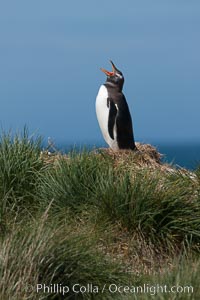
Gentoo penguin, vocalizing, atop of hill of tall tussock grass.
Species: Gentoo penguin, Pygoscelis papua
Location: Carcass Island, Falkland Islands, United Kingdom
Image ID: 23983
Species: Gentoo penguin, Pygoscelis papua
Location: Carcass Island, Falkland Islands, United Kingdom
Image ID: 23983
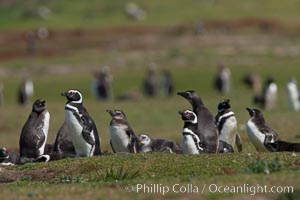
Magellanic penguins, at their burrow in short grass, in the interior of Carcass Island.
Species: Magellanic penguin, Spheniscus magellanicus
Location: Carcass Island, Falkland Islands, United Kingdom
Image ID: 24063
Species: Magellanic penguin, Spheniscus magellanicus
Location: Carcass Island, Falkland Islands, United Kingdom
Image ID: 24063
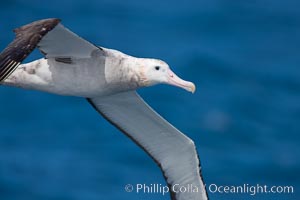
Wandering albatross in flight, over the open sea. The wandering albatross has the largest wingspan of any living bird, with the wingspan between, up to 12' from wingtip to wingtip. It can soar on the open ocean for hours at a time, riding the updrafts from individual swells, with a glide ratio of 22 units of distance for every unit of drop. The wandering albatross can live up to 23 years. They hunt at night on the open ocean for cephalopods, small fish, and crustaceans. The survival of the species is at risk due to mortality from long-line fishing gear.
Species: Wandering albatross, Diomedea exulans
Location: Southern Ocean
Image ID: 24070
Species: Wandering albatross, Diomedea exulans
Location: Southern Ocean
Image ID: 24070
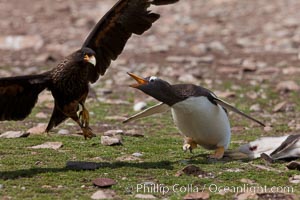
Gentoo penguin defends its dead chick (right), from the striated caracara (left) that has just killed it. The penguin continued to defend its lifeless chick for hours, in spite of the futility and inevitability of the final result. Striated caracaras eventually took possession of the dead chick and fed upon it.
Species: Gentoo penguin, Striated caracara, Phalcoboenus australis, Pygoscelis papua
Location: Steeple Jason Island, Falkland Islands, United Kingdom
Image ID: 24075
Species: Gentoo penguin, Striated caracara, Phalcoboenus australis, Pygoscelis papua
Location: Steeple Jason Island, Falkland Islands, United Kingdom
Image ID: 24075
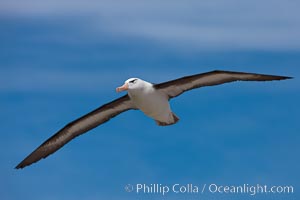
Black-browed albatross in flight, against a blue sky. Black-browed albatrosses have a wingspan reaching up to 8', weigh up to 10 lbs and can live 70 years. They roam the open ocean for food and return to remote islands for mating and rearing their chicks.
Species: Black-browed albatross, Thalassarche melanophrys
Location: Steeple Jason Island, Falkland Islands, United Kingdom
Image ID: 24076
Species: Black-browed albatross, Thalassarche melanophrys
Location: Steeple Jason Island, Falkland Islands, United Kingdom
Image ID: 24076
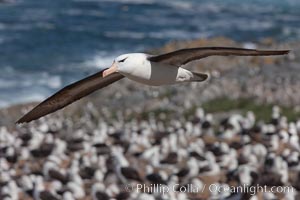
Black-browed albatross in flight, over the enormous colony at Steeple Jason Island in the Falklands.
Species: Black-browed albatross, Thalassarche melanophrys
Location: Steeple Jason Island, Falkland Islands, United Kingdom
Image ID: 24081
Species: Black-browed albatross, Thalassarche melanophrys
Location: Steeple Jason Island, Falkland Islands, United Kingdom
Image ID: 24081
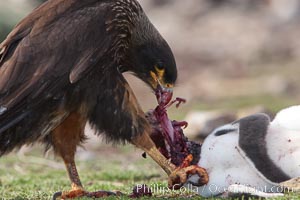
Striated caracara feeds upon a gentoo penguin chick it has just killed.
Species: Gentoo penguin, Striated caracara, Phalcoboenus australis, Pygoscelis papua
Location: Steeple Jason Island, Falkland Islands, United Kingdom
Image ID: 24086
Species: Gentoo penguin, Striated caracara, Phalcoboenus australis, Pygoscelis papua
Location: Steeple Jason Island, Falkland Islands, United Kingdom
Image ID: 24086
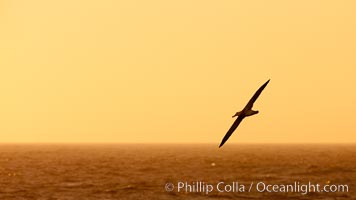
Wandering albatross in flight, over the open sea. The wandering albatross has the largest wingspan of any living bird, with the wingspan between, up to 12' from wingtip to wingtip. It can soar on the open ocean for hours at a time, riding the updrafts from individual swells, with a glide ratio of 22 units of distance for every unit of drop. The wandering albatross can live up to 23 years. They hunt at night on the open ocean for cephalopods, small fish, and crustaceans. The survival of the species is at risk due to mortality from long-line fishing gear.
Species: Wandering albatross, Diomedea exulans
Location: Southern Ocean
Image ID: 24092
Species: Wandering albatross, Diomedea exulans
Location: Southern Ocean
Image ID: 24092
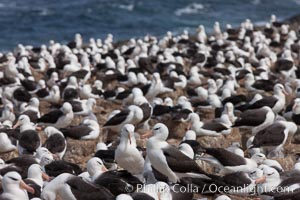
Black-browed albatross colony on Steeple Jason Island in the Falklands. This is the largest breeding colony of black-browed albatrosses in the world, numbering in the hundreds of thousands of breeding pairs. The albatrosses lay eggs in September and October, and tend a single chick that will fledge in about 120 days.
Species: Black-browed albatross, Thalassarche melanophrys
Location: Steeple Jason Island, Falkland Islands, United Kingdom
Image ID: 24110
Species: Black-browed albatross, Thalassarche melanophrys
Location: Steeple Jason Island, Falkland Islands, United Kingdom
Image ID: 24110
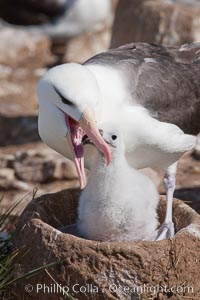
Black-browed albatross, feeding its chick on the nest by regurgitating food it was swallowed while foraging at sea, Steeple Jason Island breeding colony. The single egg is laid in September or October. Incubation takes 68 to 71 days, after which the chick is tended alternately by both adults until it fledges about 120 days later.
Species: Black-browed albatross, Thalassarche melanophrys
Location: Steeple Jason Island, Falkland Islands, United Kingdom
Image ID: 24117
Species: Black-browed albatross, Thalassarche melanophrys
Location: Steeple Jason Island, Falkland Islands, United Kingdom
Image ID: 24117
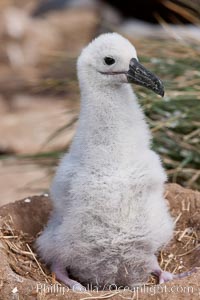
Black-browed albatross chick on its nest, Steeple Jason Island breeding colony. The single egg is laid in September or October. Incubation takes 68 to 71 days, after which the chick is tended alternately by both adults until it fledges about 120 days later.
Species: Black-browed albatross, Thalassarche melanophrys
Location: Steeple Jason Island, Falkland Islands, United Kingdom
Image ID: 24152
Species: Black-browed albatross, Thalassarche melanophrys
Location: Steeple Jason Island, Falkland Islands, United Kingdom
Image ID: 24152
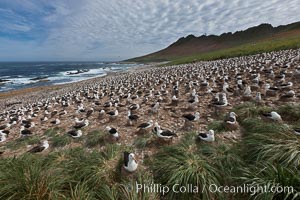
Black-browed albatross colony on Steeple Jason Island in the Falklands. This is the largest breeding colony of black-browed albatrosses in the world, numbering in the hundreds of thousands of breeding pairs. The albatrosses lay eggs in September and October, and tend a single chick that will fledge in about 120 days.
Species: Black-browed albatross, Thalassarche melanophrys
Location: Steeple Jason Island, Falkland Islands, United Kingdom
Image ID: 24224
Species: Black-browed albatross, Thalassarche melanophrys
Location: Steeple Jason Island, Falkland Islands, United Kingdom
Image ID: 24224
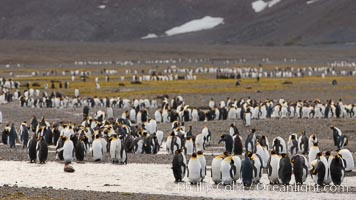
King penguin colony, Right Whale Bay, South Georgia Island. Over 100,000 pairs of king penguins nest on South Georgia Island each summer.
Species: King penguin, Aptenodytes patagonicus
Location: Right Whale Bay, South Georgia Island
Image ID: 24316
Species: King penguin, Aptenodytes patagonicus
Location: Right Whale Bay, South Georgia Island
Image ID: 24316
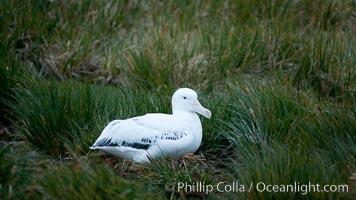
Wandering albatross, on nest in the Prion Island colony. The wandering albatross has the largest wingspan of any living bird, with the wingspan between, up to 12' from wingtip to wingtip. It can soar on the open ocean for hours at a time, riding the updrafts from individual swells, with a glide ratio of 22 units of distance for every unit of drop. The wandering albatross can live up to 23 years. They hunt at night on the open ocean for cephalopods, small fish, and crustaceans. The survival of the species is at risk due to mortality from long-line fishing gear.
Species: Wandering albatross, Diomedea exulans
Location: Prion Island, South Georgia Island
Image ID: 24394
Species: Wandering albatross, Diomedea exulans
Location: Prion Island, South Georgia Island
Image ID: 24394
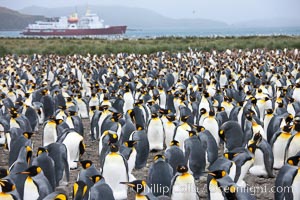
Icebreaker M/V Polar Star anchored in the Bay of Isles,offshore of the vast king penguin colony at Salisbury Plain.
Species: King penguin, Aptenodytes patagonicus
Location: Salisbury Plain, South Georgia Island
Image ID: 24397
Species: King penguin, Aptenodytes patagonicus
Location: Salisbury Plain, South Georgia Island
Image ID: 24397
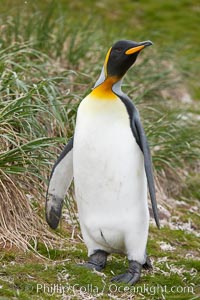
King penguin at Salisbury Plain, Bay of Isles, South Georgia Island.
Species: King penguin, Aptenodytes patagonicus
Location: Salisbury Plain, South Georgia Island
Image ID: 24398
Species: King penguin, Aptenodytes patagonicus
Location: Salisbury Plain, South Georgia Island
Image ID: 24398
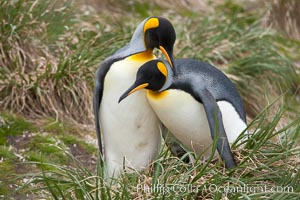
King penguin, mated pair courting, displaying courtship behavior including mutual preening.
Species: King penguin, Aptenodytes patagonicus
Location: Salisbury Plain, South Georgia Island
Image ID: 24399
Species: King penguin, Aptenodytes patagonicus
Location: Salisbury Plain, South Georgia Island
Image ID: 24399
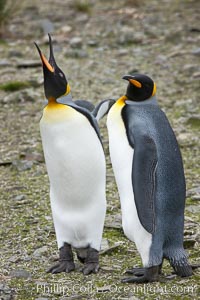
King penguin, mated pair courting, displaying courtship behavior.
Species: King penguin, Aptenodytes patagonicus
Location: Salisbury Plain, South Georgia Island
Image ID: 24400
Species: King penguin, Aptenodytes patagonicus
Location: Salisbury Plain, South Georgia Island
Image ID: 24400
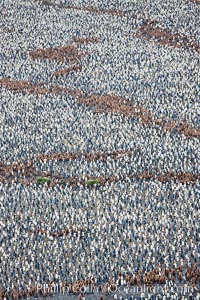
King penguin colony, over 100,000 nesting pairs, viewed from above. The brown patches are groups of 'oakum boys', juveniles in distinctive brown plumage. Salisbury Plain, Bay of Isles, South Georgia Island.
Species: King penguin, Aptenodytes patagonicus
Location: Salisbury Plain, South Georgia Island
Image ID: 24404
Species: King penguin, Aptenodytes patagonicus
Location: Salisbury Plain, South Georgia Island
Image ID: 24404
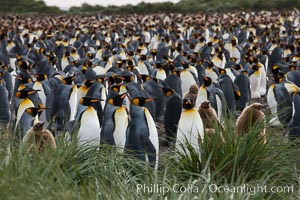
King penguin colony. Over 100,000 pairs of king penguins nest at Salisbury Plain, laying eggs in December and February, then alternating roles between foraging for food and caring for the egg or chick.
Species: King penguin, Aptenodytes patagonicus
Location: Salisbury Plain, South Georgia Island
Image ID: 24407
Species: King penguin, Aptenodytes patagonicus
Location: Salisbury Plain, South Georgia Island
Image ID: 24407
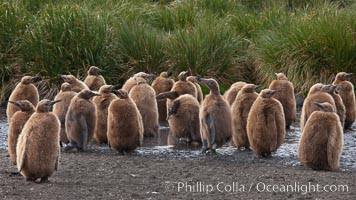
Oakum boys, juvenile king penguins at Salisbury Plain, South Georgia Island. Named 'oakum boys' by sailors for the resemblance of their brown fluffy plumage to the color of oakum used to caulk timbers on sailing ships, these year-old penguins will soon shed their fluffy brown plumage and adopt the colors of an adult.
Species: King penguin, Aptenodytes patagonicus
Location: Salisbury Plain, South Georgia Island
Image ID: 24408
Species: King penguin, Aptenodytes patagonicus
Location: Salisbury Plain, South Georgia Island
Image ID: 24408
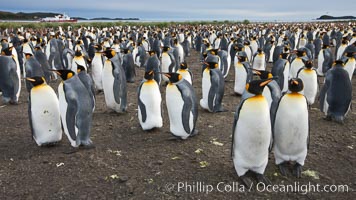
King penguin colony. Over 100,000 pairs of king penguins nest at Salisbury Plain, laying eggs in December and February, then alternating roles between foraging for food and caring for the egg or chick.
Species: King penguin, Aptenodytes patagonicus
Location: Salisbury Plain, South Georgia Island
Image ID: 24409
Species: King penguin, Aptenodytes patagonicus
Location: Salisbury Plain, South Georgia Island
Image ID: 24409
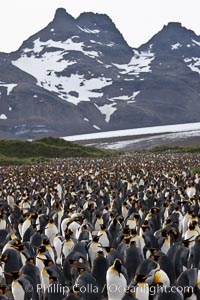
King penguin colony at Salisbury Plain, Bay of Isles, South Georgia Island. Over 100,000 pairs of king penguins nest here, laying eggs in December and February, then alternating roles between foraging for food and caring for the egg or chick.
Species: King penguin, Aptenodytes patagonicus
Location: Salisbury Plain, South Georgia Island
Image ID: 24410
Species: King penguin, Aptenodytes patagonicus
Location: Salisbury Plain, South Georgia Island
Image ID: 24410
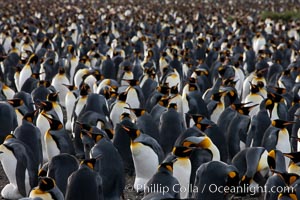
King penguin colony at Salisbury Plain, Bay of Isles, South Georgia Island. Over 100,000 pairs of king penguins nest here, laying eggs in December and February, then alternating roles between foraging for food and caring for the egg or chick.
Species: King penguin, Aptenodytes patagonicus
Location: Salisbury Plain, South Georgia Island
Image ID: 24411
Species: King penguin, Aptenodytes patagonicus
Location: Salisbury Plain, South Georgia Island
Image ID: 24411
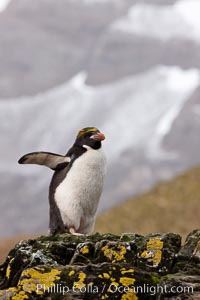
Macaroni penguin, on the rocky shoreline of Hercules Bay, South Georgia Island. One of the crested penguin species, the macaroni penguin bears a distinctive yellow crest on its head. They grow to be about 12 lb and 28" high. Macaroni penguins eat primarily krill and other crustaceans, small fishes and cephalopods.
Species: Macaroni penguin, Eudyptes chrysolophus
Location: Hercules Bay, South Georgia Island
Image ID: 24421
Species: Macaroni penguin, Eudyptes chrysolophus
Location: Hercules Bay, South Georgia Island
Image ID: 24421
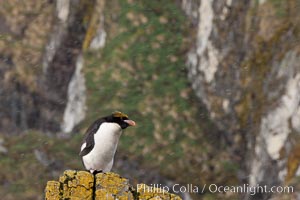
Macaroni penguin, on the rocky shoreline of Hercules Bay, South Georgia Island. One of the crested penguin species, the macaroni penguin bears a distinctive yellow crest on its head. They grow to be about 12 lb and 28" high. Macaroni penguins eat primarily krill and other crustaceans, small fishes and cephalopods.
Species: Macaroni penguin, Eudyptes chrysolophus
Location: Hercules Bay, South Georgia Island
Image ID: 24424
Species: Macaroni penguin, Eudyptes chrysolophus
Location: Hercules Bay, South Georgia Island
Image ID: 24424
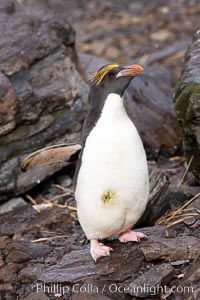
Macaroni penguin, on the rocky shoreline of Hercules Bay, South Georgia Island. One of the crested penguin species, the macaroni penguin bears a distinctive yellow crest on its head. They grow to be about 12 lb and 28" high. Macaroni penguins eat primarily krill and other crustaceans, small fishes and cephalopods.
Species: Macaroni penguin, Eudyptes chrysolophus
Location: Hercules Bay, South Georgia Island
Image ID: 24426
Species: Macaroni penguin, Eudyptes chrysolophus
Location: Hercules Bay, South Georgia Island
Image ID: 24426
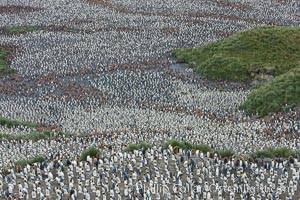
King penguin colony, over 100,000 nesting pairs, viewed from above. The brown patches are groups of 'oakum boys', juveniles in distinctive brown plumage. Salisbury Plain, Bay of Isles, South Georgia Island.
Species: King penguin, Aptenodytes patagonicus
Location: Salisbury Plain, South Georgia Island
Image ID: 24447
Species: King penguin, Aptenodytes patagonicus
Location: Salisbury Plain, South Georgia Island
Image ID: 24447
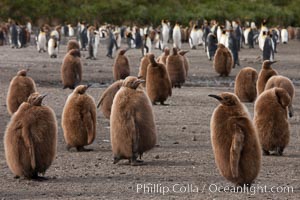
Oakum boys, juvenile king penguins at Salisbury Plain, South Georgia Island. Named 'oakum boys' by sailors for the resemblance of their brown fluffy plumage to the color of oakum used to caulk timbers on sailing ships, these year-old penguins will soon shed their fluffy brown plumage and adopt the colors of an adult.
Species: King penguin, Aptenodytes patagonicus
Location: Salisbury Plain, South Georgia Island
Image ID: 24455
Species: King penguin, Aptenodytes patagonicus
Location: Salisbury Plain, South Georgia Island
Image ID: 24455
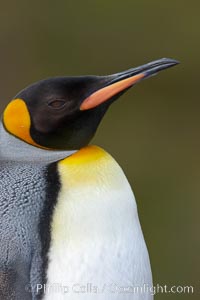
King penguin, showing ornate and distinctive neck, breast and head plumage and orange beak.
Species: King penguin, Aptenodytes patagonicus
Location: Fortuna Bay, South Georgia Island
Image ID: 24599
Species: King penguin, Aptenodytes patagonicus
Location: Fortuna Bay, South Georgia Island
Image ID: 24599